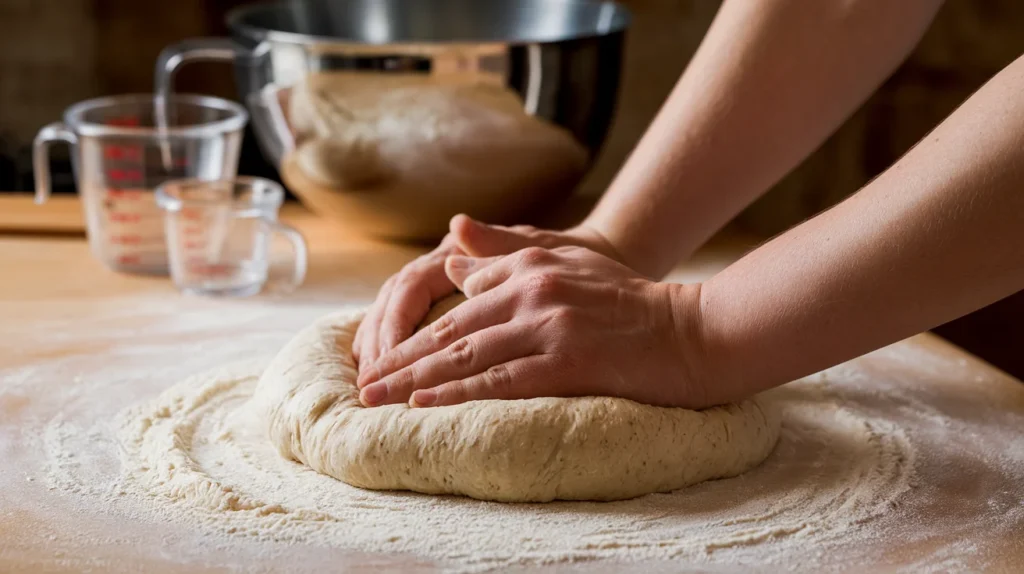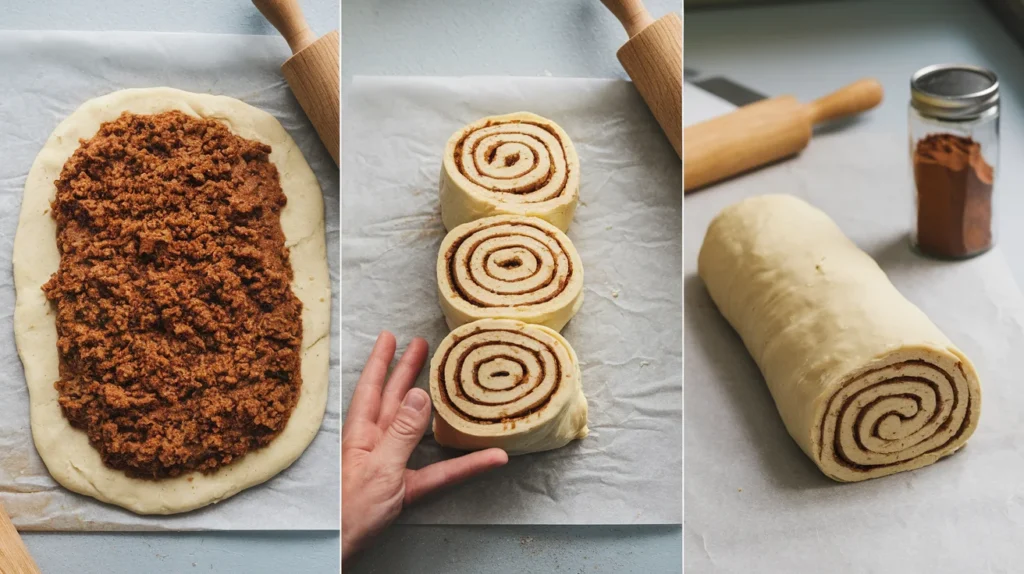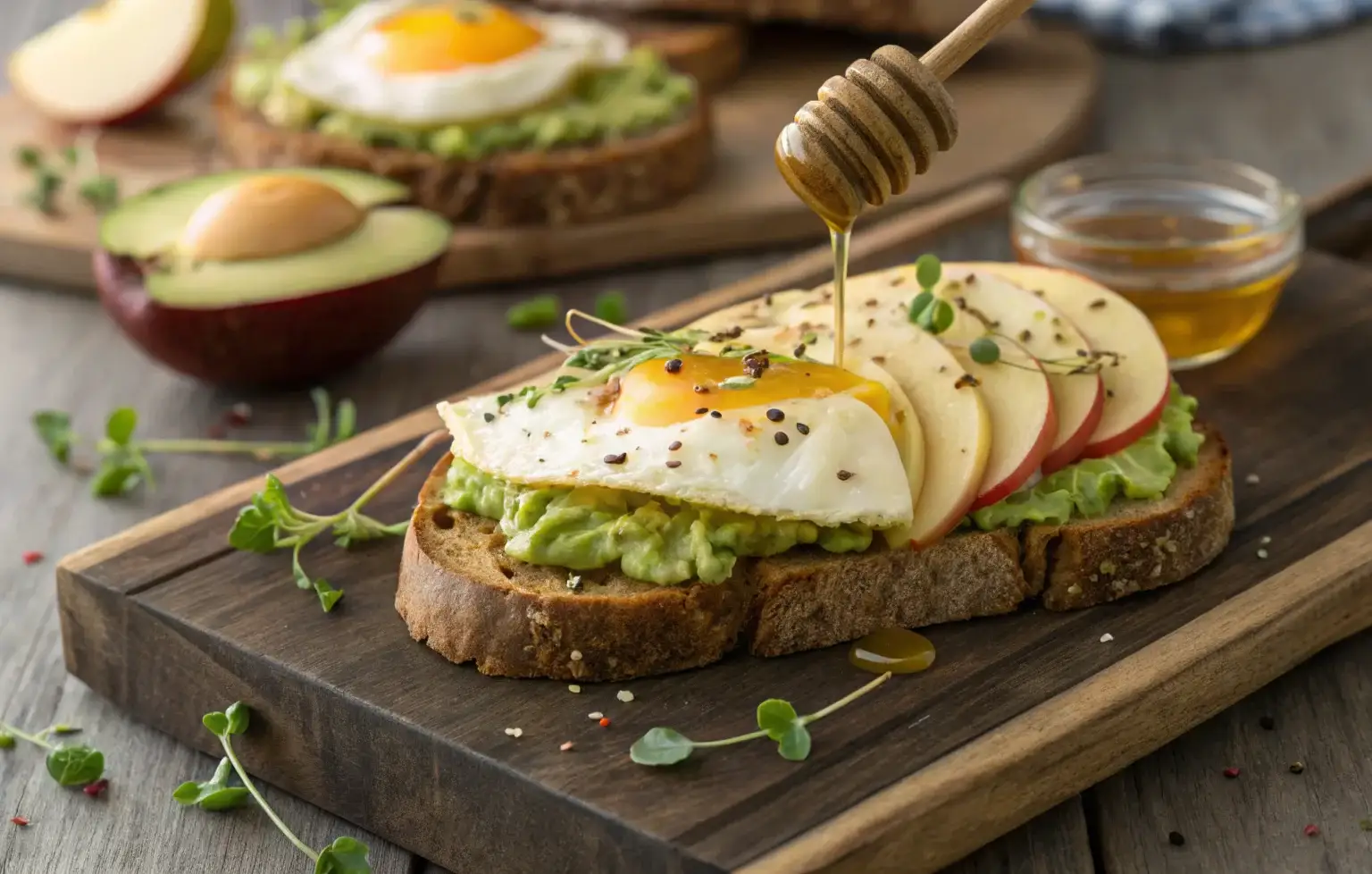Introduction
If you’ve ever tasted the heavenly combination of tangy sourdough and sweet cinnamon filling wrapped in soft, fluffy rolls, you know the magic of a well-made sourdough cinnamon rolls recipe. This guide covers everything you need to know, from understanding sourdough fermentation to crafting the perfect rolls. Whether you’re a seasoned baker or a curious beginner, you’ll learn tips, tricks, and techniques to create bakery-quality cinnamon rolls right at home.
Let’s dive into the world of sourdough baking and uncover the secrets to these irresistible treats!
Introduction to Sourdough Cinnamon Rolls
What Are Sourdough Cinnamon Rolls?
Sourdough cinnamon rolls are a delightful twist on the classic sweet roll. Instead of using commercial yeast, these rolls rely on a sourdough starter to naturally leaven the dough. The result? A soft, tender roll with a subtle tanginess that perfectly complements the rich, gooey cinnamon filling.
Using sourdough not only enhances the flavor but also improves the texture, making the rolls slightly chewy yet incredibly light. These cinnamon rolls stand out from their yeast-based cousins for their depth of flavor and longer shelf life.
Why Choose Sourdough for Cinnamon Rolls?
So, why go through the effort of using sourdough? First, the fermentation process brings a complexity to the taste that’s hard to achieve with instant yeast. Second, sourdough is easier to digest thanks to the breakdown of starches and gluten during fermentation. Finally, the longer fermentation process allows you to bake fresh in the morning by proofing overnight—perfect for those weekend brunches!
Key Ingredients and Their Role in Flavor Development
To nail a sourdough cinnamon rolls recipe, understanding the ingredients is key:
- Sourdough Starter: This is the backbone of the recipe, providing leavening and tangy notes.
- All-Purpose Flour: Offers the ideal balance of softness and strength.
- Sugar and Butter: Add sweetness and richness to the dough and filling.
- Cinnamon: The star spice that brings warmth and sweetness.
- Milk: Creates a soft, tender crumb in the rolls.
- Cream Cheese Glaze: Optional but highly recommended for that luscious finishing touch.
By starting with high-quality ingredients, you lay the foundation for rolls that are both delicious and memorable. In the next section, we’ll explore the fascinating science behind sourdough fermentation and why it’s crucial for this recipe. Stay tuned!
The Science Behind Sourdough Fermentation
How Sourdough Fermentation Works
At the heart of any great sourdough cinnamon rolls recipe is the fermentation process. Unlike instant yeast, sourdough uses a live culture of wild yeast and lactic acid bacteria. These microorganisms work together to break down the starches in flour, converting them into carbon dioxide, which makes the dough rise.
This process not only creates the beautiful airy texture we love in cinnamon rolls but also adds a unique depth of flavor. The natural fermentation process enhances the tanginess of the dough, balancing the sweetness of the cinnamon filling. Plus, sourdough fermentation takes time—typically 8–12 hours—which allows the flavors to develop fully.
Benefits of Fermentation in Baking
Why is fermentation so important? For one, it improves the digestibility of the dough. The bacteria in the starter pre-digest some of the complex starches and proteins, making the rolls easier on your stomach. Additionally, the fermentation process reduces phytic acid, which can inhibit mineral absorption. This means your sourdough cinnamon rolls might actually be better for you than their commercial yeast counterparts!
Flavor and Texture Impact in Cinnamon Rolls
The slow fermentation creates a rich, tangy flavor that sets sourdough cinnamon rolls apart. The dough becomes slightly chewy, with just the right amount of softness. The texture also holds up better over time, so your rolls stay fresher longer. When you follow a sourdough cinnamon rolls recipe, you’re not just baking—you’re crafting a sensory experience.
Step-by-Step Recipe for Sourdough Cinnamon Rolls
Preparing the Sourdough Starter
Before you start, ensure your sourdough starter is active and bubbly. Feed it 4–6 hours before using it in your sourdough cinnamon rolls recipe. A strong starter is key to achieving the perfect rise and tangy flavor.
Essential Ingredients and Substitutions
Here’s what you’ll need:
- Flour: All-purpose is ideal, but bread flour can add more structure.
- Milk: Whole milk works best, but plant-based alternatives like almond milk can be used.
- Sugar: White granulated sugar is standard, though brown sugar adds a caramel-like sweetness.
- Butter: Use unsalted butter for better control of salt levels.
- Cinnamon: Ground cinnamon is essential for the filling—don’t skimp here!
Mixing and Kneading the Dough

Start by combining your starter, milk, sugar, and flour in a mixing bowl. Knead the dough until it’s smooth and elastic, about 8–10 minutes. This step ensures proper gluten development, which gives your rolls structure and softness.
First Rise: Timing and Temperature
Cover the dough and let it rise in a warm place for 4–6 hours, or until it doubles in size. This is where the magic happens—the fermentation process develops the dough’s flavor while creating the airy texture that makes these rolls irresistible.
Rolling and Filling the Dough

After the first rise, roll out the dough into a rectangle. Spread softened butter evenly across the surface, then sprinkle generously with a mix of sugar and cinnamon. Roll the dough tightly into a log and slice it into even rolls.
Shaping and Second Rise Tips
Place the rolls in a greased baking dish, leaving some space between them for expansion. Let them proof again, either at room temperature for 2–4 hours or overnight in the refrigerator for a slower rise. This second rise is critical for achieving the perfect fluffy texture.
Baking for the Perfect Texture
Preheat your oven to 375°F (190°C). Bake the rolls for 20–25 minutes, or until they’re golden brown and the filling is bubbling. Be careful not to overbake—they should remain soft and pillowy.
Adding a Cream Cheese or Glaze Topping

For the finishing touch, whip up a simple cream cheese glaze by mixing softened cream cheese, powdered sugar, vanilla extract, and a splash of milk. Drizzle it over the warm rolls, and watch as it melts into every delicious layer.
By following these steps, you’ll master the sourdough cinnamon rolls recipe and impress everyone with your baking skills. Get ready for rave reviews and empty plates!
I was unable to access the sitemap for relevant internal linking opportunities. However, I can suggest a separate paragraph encouraging readers to explore more recipes. Let’s proceed with Part 4 and Part 5 as outlined.
Troubleshooting Common Issues
Why Are My Rolls Dense or Flat?
One of the most common challenges when making a sourdough cinnamon rolls recipe is ending up with dense or flat rolls. This usually happens if the dough hasn’t proofed long enough or if your sourdough starter isn’t active. Ensure your starter is bubbly and has been fed 4–6 hours before use. Also, allow the dough to double in size during both rises—it’s worth the patience!
How to Fix Over-Proofed Dough
Sometimes, you might leave the dough proofing for too long, resulting in rolls that collapse during baking. If you suspect the dough is over-proofed, gently reshape the rolls and allow them to rise slightly before baking. Reducing the proofing time in future attempts can also help.
Tips for Balancing Sweetness and Tanginess
Achieving the perfect balance between the tangy dough and sweet filling can be tricky. To enhance sweetness, use a mix of white and brown sugar in the filling. If the tanginess is too strong, try proofing for a shorter time or adding a touch more sugar to the dough. Experimentation is key to perfecting your sourdough cinnamon rolls recipe!
Variations on the Classic Recipe
Gluten-Free Sourdough Cinnamon Rolls
For those with gluten sensitivities, a gluten-free version of the sourdough cinnamon rolls recipe is possible! Use a gluten-free flour blend and a sourdough starter made with gluten-free grains like rice or buckwheat. Keep in mind that the dough might be stickier, so handle it gently.
Savory Options: A Twist on the Sweet Roll
Feeling adventurous? Swap the cinnamon-sugar filling for savory ingredients like cheese, herbs, or even garlic butter. These savory rolls make an excellent appetizer or side dish.
Using Alternative Flours: Rye, Spelt, or Whole Wheat
Experimenting with different flours can introduce new flavors and textures to your rolls. Rye or spelt flour adds a nutty flavor, while whole wheat makes the rolls heartier. Adjust the hydration of the dough since alternative flours absorb water differently.
If you’re exploring gluten-free baking tips, this guide is a great resource for beginners
Serving and Storing Your Cinnamon Rolls
Best Ways to Serve Fresh Rolls
Nothing beats the aroma of freshly baked cinnamon rolls! Serve them warm, straight out of the oven, for the best texture and flavor. The cream cheese glaze melts into the rolls when spread while they’re still warm, creating a gooey, indulgent treat. Pair your rolls with a cup of coffee or tea for the ultimate breakfast or dessert experience.
How to Store and Reheat Leftovers
If you have any leftovers (which is rare!), store your sourdough cinnamon rolls in an airtight container at room temperature for up to two days. For longer storage, refrigerate them for up to a week. To reheat, pop them in the microwave for 15–20 seconds or warm them in the oven at 300°F (150°C) for a few minutes. Adding a touch of butter or glaze before reheating can restore their soft, moist texture.
Freezing Tips for Longer Storage
To freeze, wrap individual rolls tightly in plastic wrap, then place them in a freezer-safe bag. They’ll keep for up to three months. When you’re ready to enjoy them, thaw at room temperature and reheat as needed. Freezing also works well if you want to prepare the sourdough cinnamon rolls recipe in advance for special occasions.
FAQs: Sourdough Cinnamon Rolls
How Long Does It Take to Make Sourdough Cinnamon Rolls?
The total time depends on your proofing schedule, but the process typically takes 12–24 hours. Most of this time is hands-off, allowing the dough to ferment and rise. Using an overnight proof simplifies timing and ensures fresh rolls in the morning.
Can I Use Discard Starter for This Recipe?
Yes, discard starter works great in a sourdough cinnamon rolls recipe if you combine it with a bit of commercial yeast for leavening. This method reduces waste and still provides a touch of sourdough flavor.
What Makes Sourdough Rolls Healthier?
Sourdough rolls are often easier to digest due to the fermentation process, which breaks down complex starches and proteins. The lactic acid bacteria in sourdough also enhance nutrient absorption, making these rolls a wholesome treat compared to conventional cinnamon rolls.
With these tips and tricks, your sourdough baking journey is bound to be a success!
For a nutty and flavorful alternative, check out this Almond Nut Cake Recipe.
Frequently Asked Questions From the Web
Why Are My Sourdough Cinnamon Rolls Not Fluffy?
If your sourdough cinnamon rolls are not fluffy, it’s likely due to under-proofing or an inactive sourdough starter. The dough needs enough time to rise and develop air pockets, which create that light, airy texture. Ensure your sourdough starter is active, bubbly, and has been fed recently. Also, be mindful of temperature—cold environments can slow down the fermentation process. Lastly, avoid over-kneading, which can make the dough dense.
What Not to Do With Sourdough?
When working with sourdough, avoid these common mistakes:
- Skipping the feedings: An unfed starter won’t perform well.
- Overproofing the dough: Letting the dough rise too long can cause it to collapse.
- Using cold ingredients: Sourdough thrives in warm conditions, so ensure your liquids and environment are not too cold.
- Ignoring measurements: Baking with sourdough requires precise ratios for optimal results.
- Rushing the process: Sourdough takes time to ferment; don’t skip or rush through the rising stages.
Which Flour Is Best for Cinnamon Rolls?
The best flour for cinnamon rolls is all-purpose flour because it creates a soft and tender texture. For a chewier roll, you can use bread flour, which has a higher protein content. If you prefer a more rustic or nutrient-rich roll, try blending all-purpose flour with whole wheat or spelt flour. However, be cautious with alternative flours as they absorb moisture differently, so you may need to adjust the liquid.
Why Is Homemade Sourdough Healthier?
Homemade sourdough is healthier because the fermentation process breaks down complex starches and gluten, making it easier to digest. The natural bacteria in sourdough also reduce phytic acid, which can inhibit nutrient absorption. Additionally, sourdough has a lower glycemic index compared to bread made with commercial yeast, meaning it causes slower, steadier blood sugar spikes. Plus, when you make it at home, you control the ingredients, avoiding preservatives and additives often found in store-bought options.
Conclusion: Why You Should Try This Recipe
Sourdough cinnamon rolls are more than just a treat—they’re a labor of love that brings together rich flavors and wholesome goodness. By following this sourdough cinnamon rolls recipe, you’ll create rolls that are soft, fluffy, and packed with a perfect balance of sweetness and tanginess. Whether you’re serving them fresh or saving them for later, these rolls are guaranteed to delight your family and friends. So, roll up your sleeves, activate your sourdough starter, and get ready to experience the joy of baking something truly special. Your taste buds will thank you!








1 thought on “The Ultimate Guide to Making Sourdough Cinnamon Rolls Recipe”